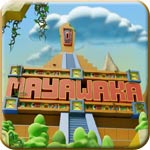- Wondering how to get Monopoly GO! free rolls? Well, you’ve come to the right place. In this guide, we provide you with a bunch of tips and tricks to get some free rolls for the hit new mobile game. We’ll …
Best Roblox Horror Games to Play Right Now – Updated Weekly
By Adele Wilson
Our Best Roblox Horror Games guide features the scariest and most creative experiences to play right now on the platform!The BEST Roblox Games of The Week – Games You Need To Play!
By Sho Roberts
Our feature shares our pick for the Best Roblox Games of the week! With our feature, we guarantee you'll find something new to play!Type Soul Clan Rarity Guide – All Legendary And Common Clans Listed!
By Nathan Ball
Wondering what your odds of rolling a particular Clan are? Wonder no more, with my handy Type Soul Clan Rarity guide.
Mayawaka Review
Take an ’80s arcade hit like Q*Bert, add a Mayan theme, and then throw in some classic mini-games such as Memory (a.k.a. Concentration) and Whack-A-Mole and you’ll end up with something like Mayawaka, a new casual game that – while unoriginal in its design – ends up being more than the sum of its mediocre parts.

Take an ’80s arcade hit like Q*Bert, add a Mayan theme, and then throw in some classic mini-games such as Memory (a.k.a. Concentration) and Whack-A-Mole and you’ll end up with something like Mayawaka, a new casual game that – while unoriginal in its design – ends up being more than the sum of its mediocre parts.
After the cryptic story is introduced (don’t ask me to explain it), the main game is a clone of Q*Bert. For the uninitiated, you control a little character who can hop up and down on connected cubes (beginning with a pyramid shape). Your goal is to step on all the cubes and turn them all from green to blue to complete the level. You must do this by avoiding the bad guys who will kill you if you land on the same cube as them. You can collect an extra life by chasing down and touching another character. Problem is, the guys you’re supposed to avoid and the ones you’re supposed to catch look similar. Instead, perhaps the developers should have made it more clear which ones were the bad guys.
In later levels, the cubed boards you hop on begins to take interesting new shapes and get tougher to complete; in level 3 you must also begin hopping on the same squares twice to turn them all from red to green to blue.
After you’ve finished one level, it’s time for you to tackle the mini-games in Mayakama, which take different forms:
- A “Whack-A-Mole” game, where you must use your mouse to click on (“whack”) a bad guy’s head when it pops up from its hole. You are penalized for taking too long to whack a baddie or if you click the wrong place.
- A falling object game, where you have a bucket and must catch as many falling items as you can before the timer runs out; the more you catch, the higher your score will be.
- A sliding tile puzzle, where you must create a Mayan statue by swapping tiles so that it forms the correct picture. This one proved to be the toughest, in my opinion, mainly because you don’t have a lot of time to complete it.
- A memory game, similar to Concentration, where you have to memorize pairs of objects, and click to pair them up. All items are facing the other way, and you must clicking to reveal them for a short amount of time.
- An object pairing game, where you first see an object rotating at the top of the screen – such as a red square, green circle or yellow triangle – and then quickly click on the identical-shaped object seen on the grid below.
Every few levels these games get harder in some way, shape or form. And after each main level – which consists of many Q*Bert-style arcade rounds and a few of the mini-games, you will earn one of eight carved totems; collect them all to win the game.
Aside from the fact gamers have seen all of these game types before, another issue is that your mouse pointer is small (it’s the regular yellow Windows one) and some levels require a clearer view of where your mouse pointer is (especially the falling object and object-pairing mini-games). Also, players are offered the option to use the keyboard instead of the mouse for the Q*Bert rounds, but it proves much harder than using the mouse since you can’t easily choose your direction on the cubes.
Look, Mayakama isn’t perfect, but it’s a fast-paced and increasingly-challenging game. It won’t win any awards for ingenuity but proves to be a fun and fulfilling time-waster nevertheless.

The good

The bad
More articles...
Monopoly GO! Free Rolls – Links For Free Dice
By Glen Fox
Wondering how to get Monopoly GO! free rolls? Well, you’ve come to the right place. In this guide, we provide you with a bunch of tips and tricks to get some free rolls for the hit new mobile game. We’ll …Best Roblox Horror Games to Play Right Now – Updated Weekly
By Adele Wilson
Our Best Roblox Horror Games guide features the scariest and most creative experiences to play right now on the platform!The BEST Roblox Games of The Week – Games You Need To Play!
By Sho Roberts
Our feature shares our pick for the Best Roblox Games of the week! With our feature, we guarantee you'll find something new to play!Type Soul Clan Rarity Guide – All Legendary And Common Clans Listed!
By Nathan Ball
Wondering what your odds of rolling a particular Clan are? Wonder no more, with my handy Type Soul Clan Rarity guide.







